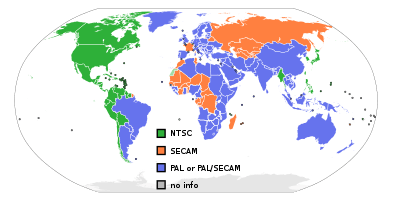PAL-M
PAL-M is the analog TV system used in Brazil since February 19, 1972. At that time, Brazil was the first South American country to broadcast in colour. Colour TV broadcast began on February 19, 1972, when the TV networks Globo and Bandeirantes transmitted the Caxias do Sul Grape Festival. Transition from black and white to colour was not complete until 1978. Two years later, in 1980, colour broadcast nationwide in Brazil was commonplace.

It is unique among analog TV systems in that it combines the 525-line 30 frames-per-second System M with the PAL colour encoding system (using very nearly the NTSC colour subcarrier frequency), unlike all other countries which pair PAL with 625-line systems and NTSC with 525-line systems.
Technical specification
Why PAL-M
NTSC being the "natural" choice for countries with monochrome standard M, the choice of a different colour system poses problems of incompatibility with available hardware and the need to develop new television sets and production hardware. Walter Bruch, inventor of PAL, explains Brazil's choice of PAL over NTSC against these odds by an advertising campaign Telefunken and Philips carried out across South America in 1972, which included colour test broadcasts of popular shows (done with TV Globo) and technical demonstrations with executives of television stations.[1]
Compatibility
PAL-M signals are identical to North American NTSC signals, except for the encoding of the colour carrier. Therefore, PAL-M will display in monochrome with sound on an NTSC set and vice versa.
PAL-M is incompatible with 625-line based versions of PAL, because its frame rate, scan line, colour subcarrier and sound carrier specifications are different. It will therefore usually give a rolling and/or squashed monochrome picture with no sound on a native European PAL television, as do NTSC signals.
PAL-M systems conversion issues
PAL-M being a standard unique to one country, the need to convert it to/from other standards often arises.
- Conversion to/from NTSC is easy, as only the colour carrier needs to be changed. Frame rate and scan lines can remain untouched.
- Conversion to/from PAL/625 lines/25 frame/s and SECAM/625/25 signals involves changing the frame rates as well as the scan lines. This is achieved using complicated circuitry involving a digital frame store, the same method used for converting between NTSC and the 625/25 standards. The fact that the colour encoding of PAL-M and PAL/625/25 is the same does not help, as the entire signal goes through an A/D-D/A conversion process anyway.
However some special VHS video recorders are available which can allow viewers the flexibility of enjoying PAL-M recordings using a standard PAL (625/50 Hz) colour TV, or even through multi-system TV sets. Video recorders like Panasonic NV-W1E (AG-W1 for the USA), AG-W2, AG-W3, NV-J700AM, Aiwa HV-MX100, HV-MX1U, Samsung SV-4000W and SV-7000W feature a digital TV system conversion circuitry. Some recorders support the other way around, being able to playback standard PAL (625/50 Hz) in 50 Hz-compatible PAL-M TV sets, such as the Panasonic NV-FJ605.
PAL 60
The PAL colour system (either baseband or with any RF system, with the normal 4.43 MHz subcarrier unlike PAL-M) can also be applied to an NTSC-like 525-line (480i) picture to form what is often known as "PAL-60" (sometimes "PAL-60/525," "Pseudo-PAL," or "Quasi-PAL"). This non-standard signal is a method used in European domestic VCRs and DVD players for playback of NTSC material on PAL televisions. It's not identical to PAL-M and incompatible with it, because the colour subcarrier is at a different frequency; it will therefore display in monochrome on PAL-M and NTSC television sets.
Technological obsolescence
ABERT/SET tests
Before SBTVD, from 1999 to 2000, the ABERT/SET group in Brazil did system comparison tests of DTV under the supervision of the CPqD foundation.
The comparison tests were done under the direction of a work group of SET and ABERT. Originally, Brazil including Argentina, Paraguay and Uruguay are planned to adopt the DVB-T system. However, the ABERT/SET group selected ISDB-T as the best system among ATSC, DVB-T and ISDB-T.
The outdoor coverage of field-tests result in "Brazilian digital television tests" show that ISDB-T is most robust system in Brazil.
SBTVD
The analog PAL-M was scheduled to be supplanted by a digital high-definition system named Sistema Brasileiro de Televisão Digital (SBTVD) by 2015, and finishing in 2018. However, SBTVD was later replaced by the Brazilian variant of the ISDB standard, ISDB-Tb, which features SBTVD's characteristics into the originally-Japanese digital norm.
References
- PAL Das Farbfernsehen Archived 2007-12-08 at the Wayback Machine; Walter Bruch/Heide Riedel; Deutsches Rundfunk-Museum 1987